In Maine, a small town battles over the future of a beloved island
For thousands of years, Sears Island has sat quiet, virtually untouched, tucked deep in Maine’s Penobscot Bay. But a new environmental development proposal puts its fate, and legacy, in question.
By Matthew Eadie in Searsport, Maine — June 18, 2024 at 9:02 p.m.
Sears Island from the half-mile-long causeway that connects the island to the mainland.
SEARSPORT, Maine
If, about 3,400 years ago, you happened to find yourself deep in the northwestern corner of Maine’s Penobscot Bay, you’d see an island, connected to the mainland by a sandbar at low tide.
You’d see the Wabanaki people resting during their trips through the bay on the island they called Wassumkeag, meaning “bright sand beach.” You’d see them fishing, hunting and paddling around the island’s edge, using it as a navigation guide as they made their way around the bay.
If you were there again in 1730, you’d find the island had been colonized by Brigadier General Samuel Waldo of Boston, who flattered himself by changing Wassumkeag’s name to “Brigadier’s Island.” A few decades later, you’d find a small farmhouse built off the side of a dirt trail. You’d see cattle, sheep, hogs and oxen grazing on the land.
By the time the Declaration of Independence was signed in 1776, you’d see a small town on the mainland across from the island, with a few dozen families settling in. This town would eventually become Searsport, named after David Sears, a Boston businessman and philanthropist, who bought Brigadier’s Island from his business partners in 1813. The island would soon get its current name: Sears Island.
Today, along Searsport’s Main Street, a few-mile stretch of Route One, a slew of construction projects engulf the quiet seaside town. Cars seldom pass down the now one-way road, while the southbound side remains fenced off, under a years-long road widening and re-pavement project.
The town, around 2,000 people, with its plethora of antique shops, bookstores, boutique inns, a Dunkin’, a few small shops, churches, restaurants and a Dollar General, has few signs of liveliness in late spring. The bitter cold hanging on from winter isn’t conducive to the tourists who often stay in and around Searsport in the summer for its close-ish proximity to Bar Harbor and Acadia National Park, about an hour and a half farther up Route One.
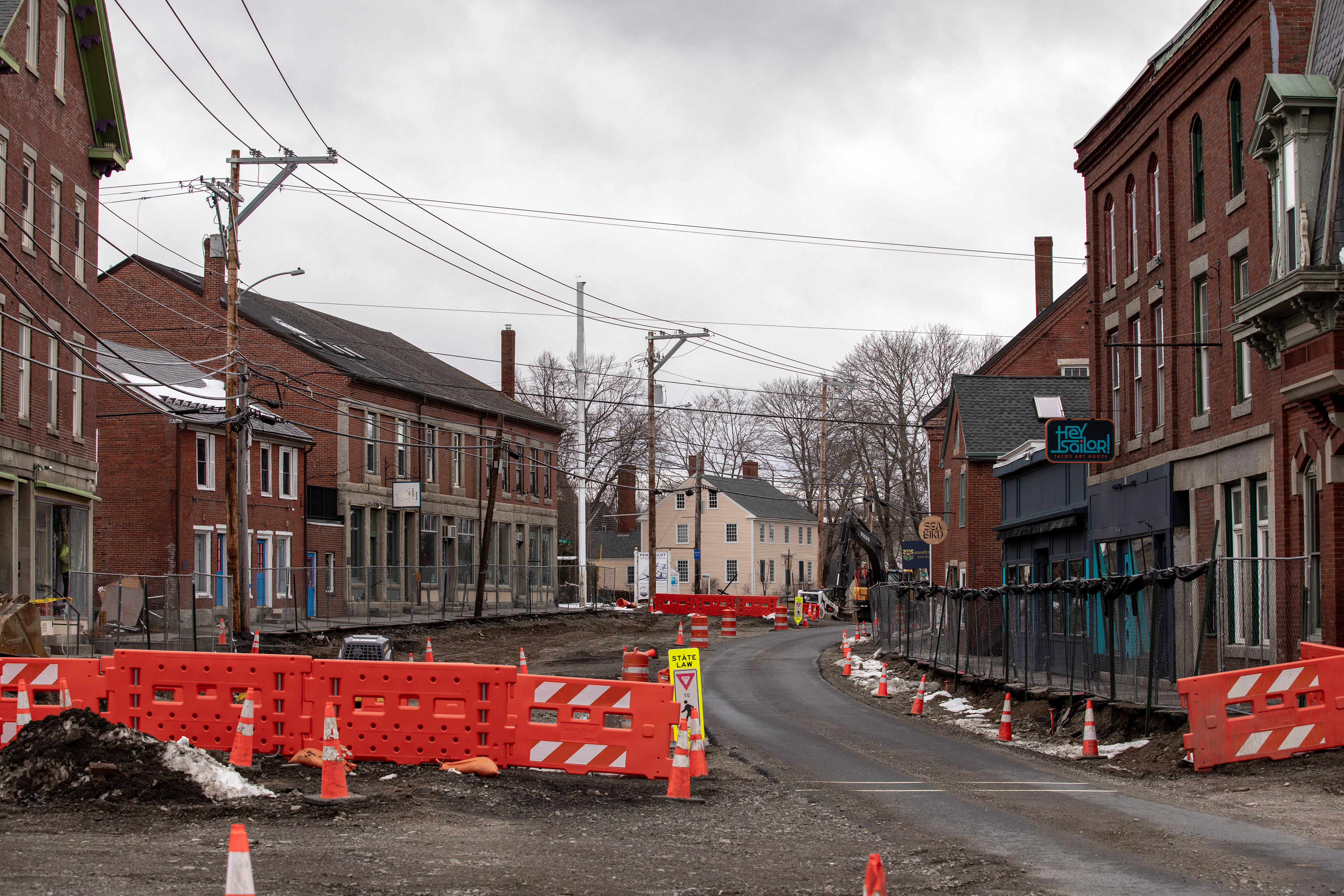
Downtown Searsport under intense construction.
But it’s quiet and serene, and many people living in Searsport like it for that very reason. It’s a retirement town for many who’ve returned to coastal Maine after years away, and for many more who sought its peacefulness and the natural surroundings that define life in the pine tree state.
Serenity, however, may not last much longer.
On Feb. 20, Maine’s Democratic governor, Janet Mills, announced part of Sears Island as the state’s preferred location for a proposed $500 million offshore wind development port — a construction, staging and launching site for Maine’s massive offshore wind project.
“The State concluded that the Sears Island parcel is the most feasible port development site in terms of location, logistics, cost and environmental impact,” a statement from the governor’s office on Feb. 20 read.
Sears Island was originally called Wassumkeag by the native Wabanaki people before it was colonized in the eighteenth century.
Sears Island, aside from a paved road up the island’s center, a singular cellular tower built on the tip of the island decades ago, a few wooden steps leading to the beach and an occasional sign, is almost entirely bare of human intervention. Building such a port would require the demolition and development of more than 100 acres, out of the island’s 941 acres, likely transforming the island’s current use of relaxation, fishing, hunting and walking through its natural environment.
To the disappointment of many in the community, although not to the huge surprise, the decision to select Sears Island was made over an alternative location, Mack Point, an already-developed and operational port site currently used for cargo just a few hundred yards across the water — although, unlike Sears Island, privately owned. The decision by the state has since caused distress among many community members, many of whom have expressed worry that the project will permanently destroy their beloved island.
But, the proposal is not the state’s first attempt to develop Sears Island. Its history, long and complicated, dates back decades, and its position today — with allegations of broken promises and the unlikeliest of bedfellows — lands it at the center of a crucial debate that could set a precedent around the country.
A precedent that could send shockwaves through American politicians’ green energy plans and could shatter relationships between environmental organizations and advocates across the country — all of whom agree that climate change must be mitigated but don’t agree on how to do it.
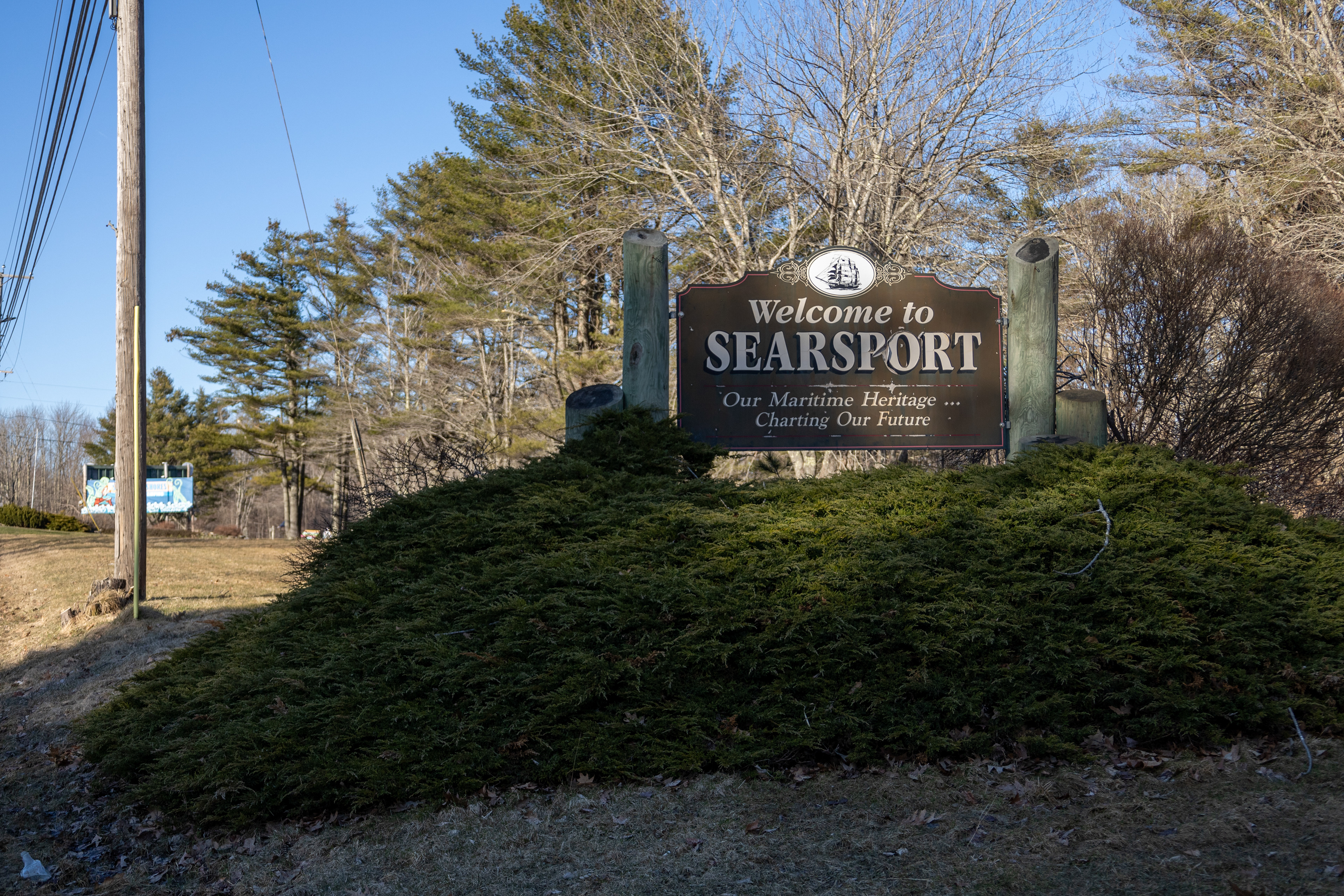
Searsport, Maine is home to only around 2,000 people.
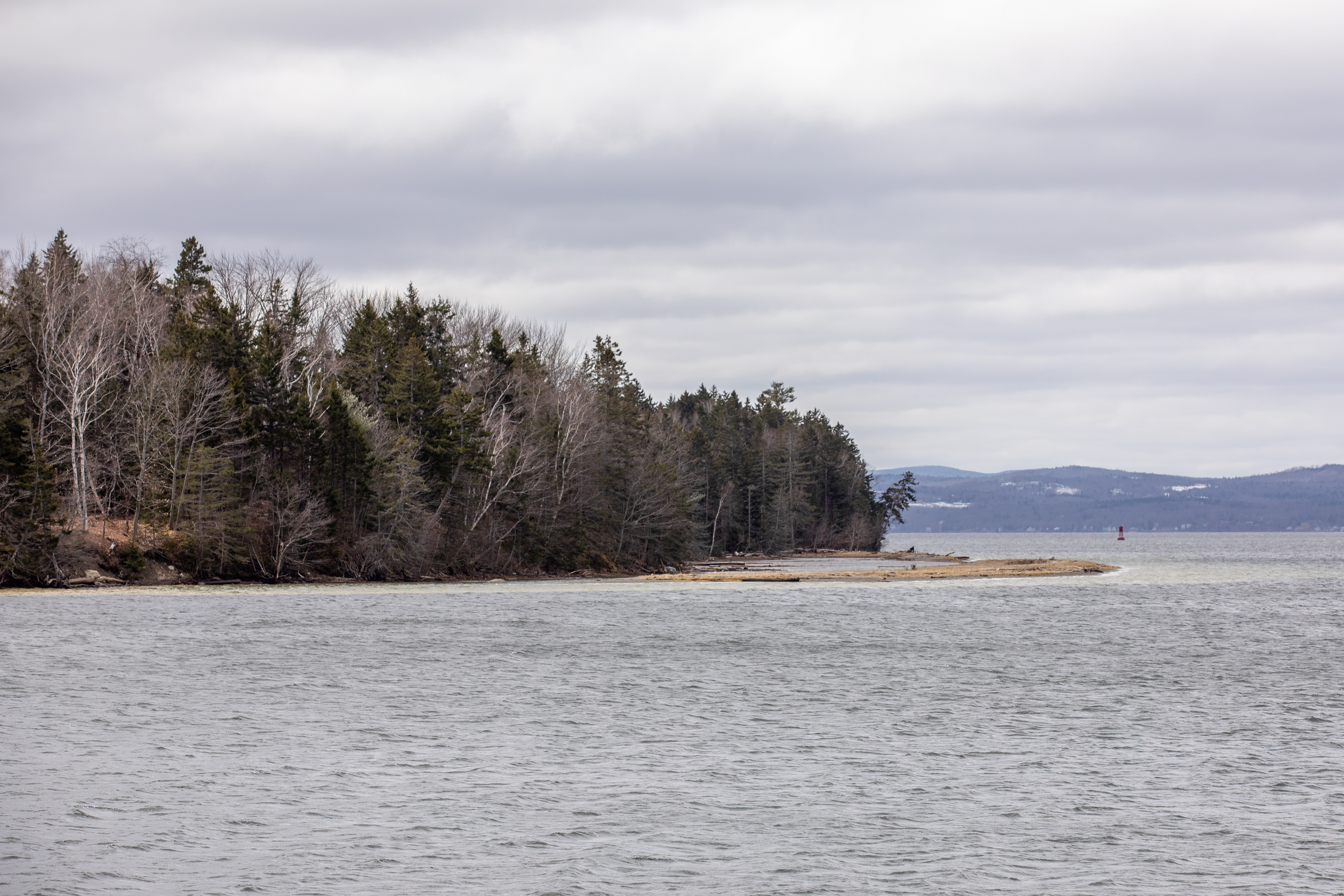
The western edge of Sears Island seen from the western beach.
Jutting out into Penobscot Bay, Sears Island can be seen all along the coast of Searsport, appearing as a long hump with its dense forest elevated from the waterline. A series of walking trails act like a spiderweb, weaving for about 11 miles throughout the island.
Despite being an island, Sears Island has always been accessible from the mainland — centuries ago due to its natural sandbar at low tide — and since the late 1980s because of a causeway built by the state to allow cars to drive and park along the long road. Roadblocks prevent civilians from driving on the island itself, though. At any time, several cars are lined up along the long road as locals walk the island’s trails. On weekends with nice weather or holidays, cars can line up along the entire stretch of the half-mile causeway.
Sears Island is a popular place not just for serious hikes through the forest but for families as well, people young and old, walking their dogs along the road or having their kids play on the beach in the summer. It was on Sears Island that Katie Giddings, a longtime resident of nearby Belfast, often took her now-9-year-old son to play and ride his bike along the long empty road.
“I used to think it was just kind of my special place,” Giddings said. “But the more people I talked to, the more I realized that kind of everyone feels that way about it.”
Giddings, now 46, was raised in the nearby town of Monroe and said she often went to Sears Island as a kid because of its financial accessibility, especially to residents of relatively lower income, which describes much of the community.
“It’s like $60 to get into Acadia, so it’s really not accessible to poor and working type families, you know, even for working-class folks that’s kinda a lot,” Giddings said. “But Sears Island has always been a beautiful and accessible place for all the local people … It’s just one of the most beautiful places we have.”
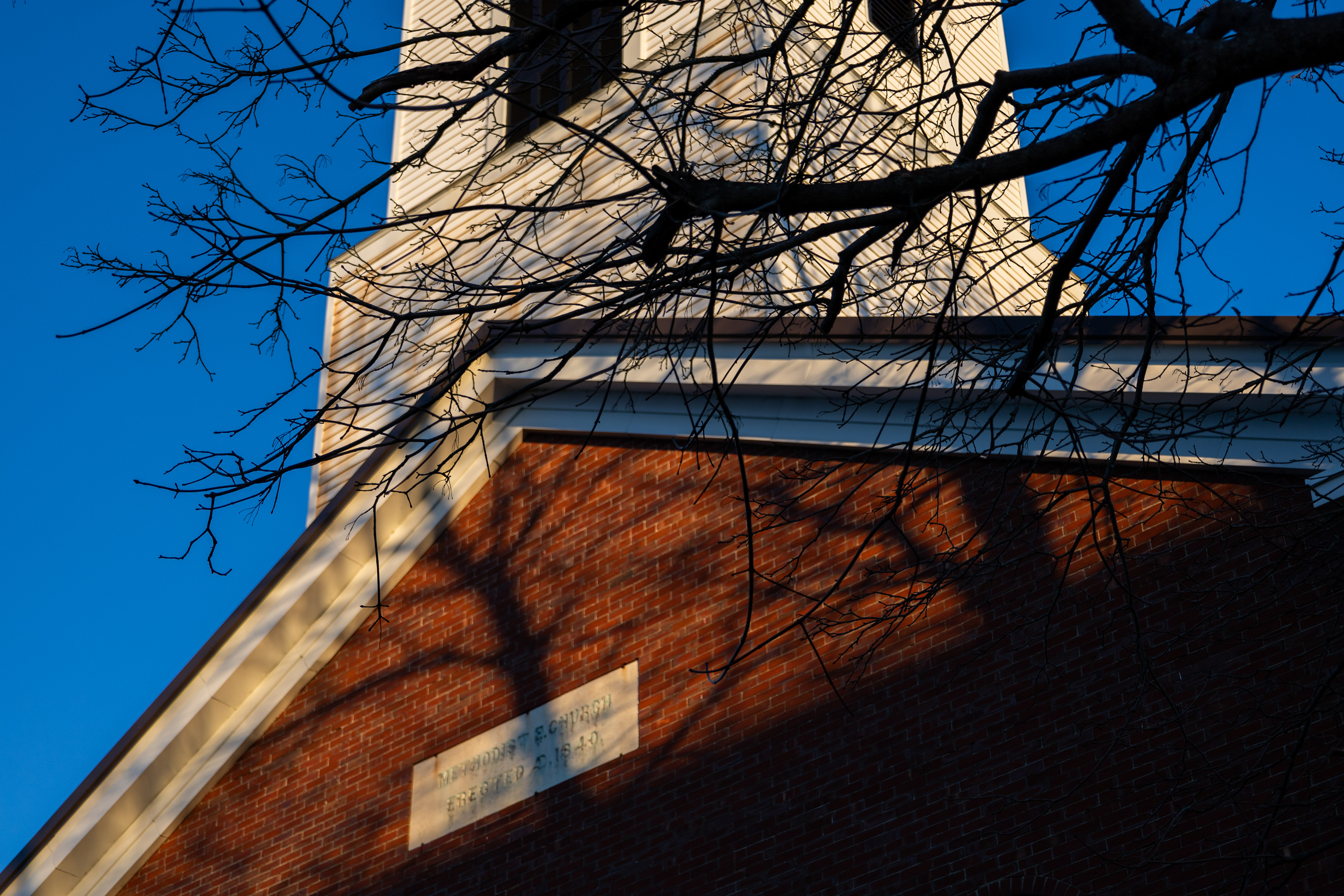
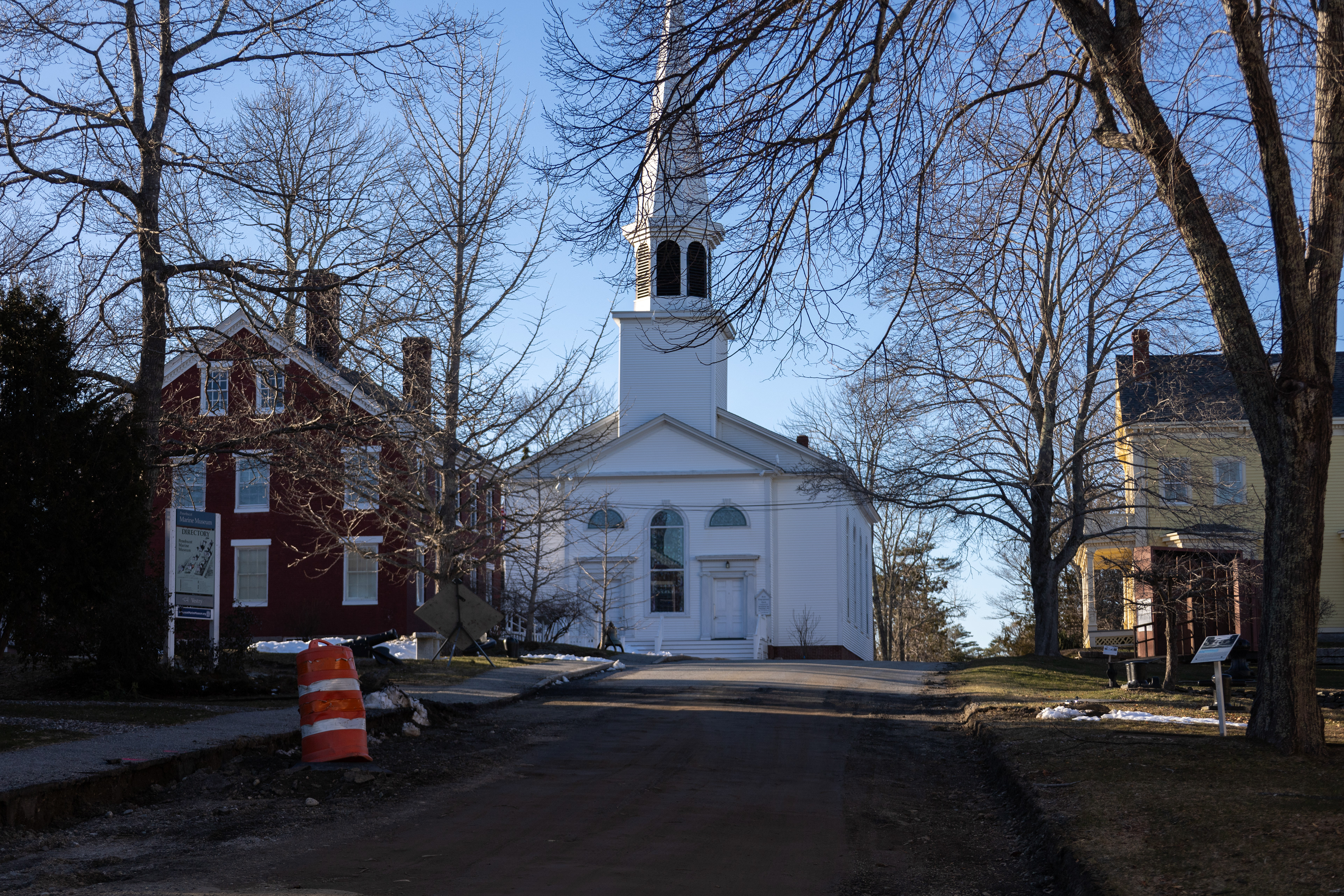
Signs of the island’s rich history are visible deep along its muddy dirt paths. The ruins of an old farmhouse built by Henry Knox, a founding father, Revolutionary War general and the first U.S. secretary of war under President George Washington, are visible off a path on the island’s northern side. Knox was married to Lucy Flucker, the daughter of Samuel Waldo.
The remains of another structure built on the land at one time are also visible, on the island’s southern edge, where the Sears family built a summer home when David Sears took ownership of the island. The building burned to the ground in the late 1800s, according to Friends of Sears Island, the organization designated responsible for preserving part of the land.
There are, however, growing signs of intervention on the island’s 330-acre western third, dubbed the “transportation parcel,” which is the portion of the island designated by the state as a potential future development area after a 2009 agreement between the state and the community. The agreement put the remainder of the island, 601 acres, in the hands of the Maine Coast Heritage Trust, which then tapped Friends of Sears Island to oversee its conservation.
Walking along the road, there are scattered trees marked with spray paint and small pink ribbons, likely signs of surveyors on the island. Pins reading “Save Sears Island” are strapped to some island-goers’ Patagonia winter coats, as they walk their dogs along the path.
It’s clear that the island is on the brink of a potential transformation.
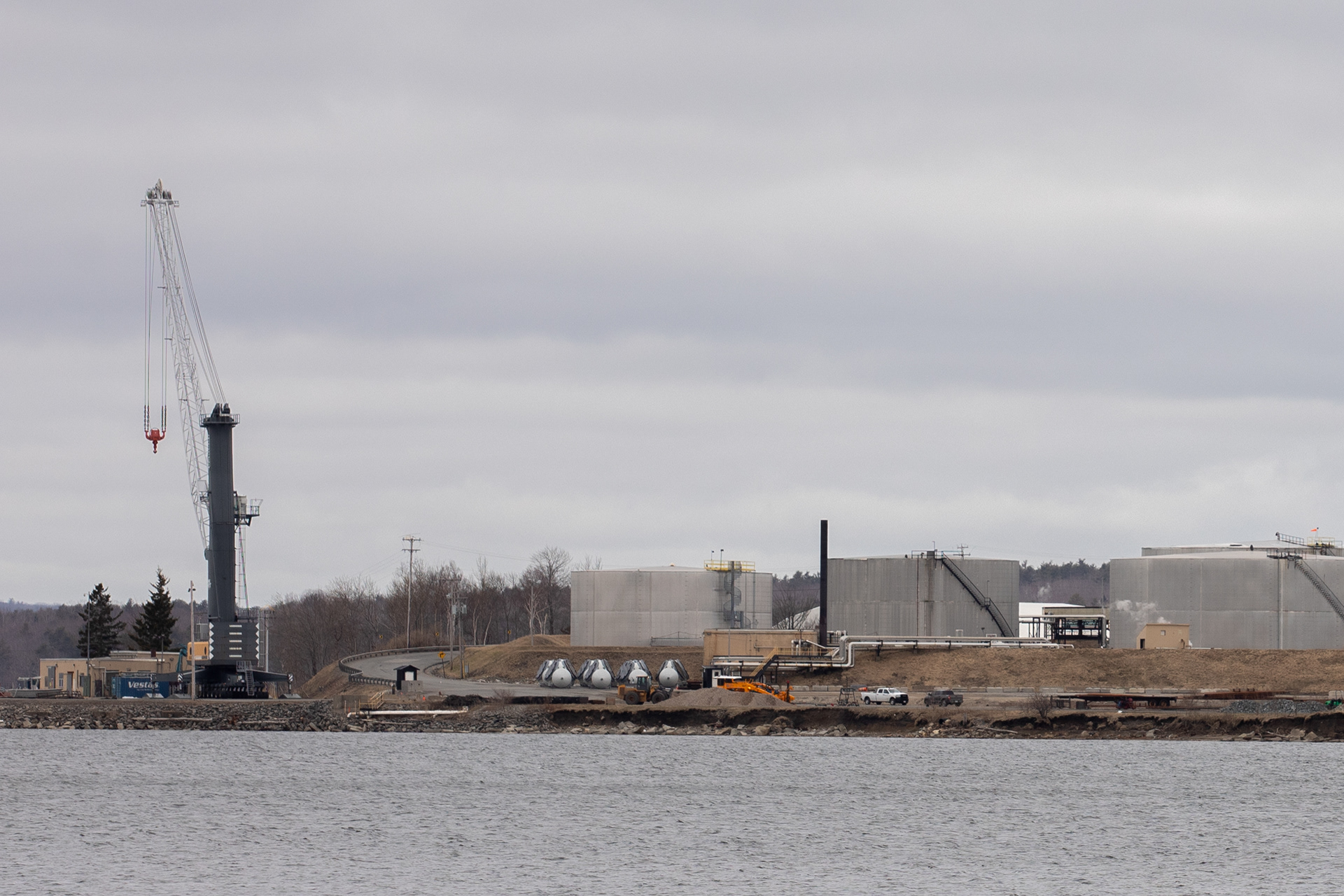
Mack Point across the water from Sears Island. Mack Point is the second location in Searsport that was considered by the state was the site for the offshore wind development port and is the favored location by several community members seeking to protect Sears Island from development.
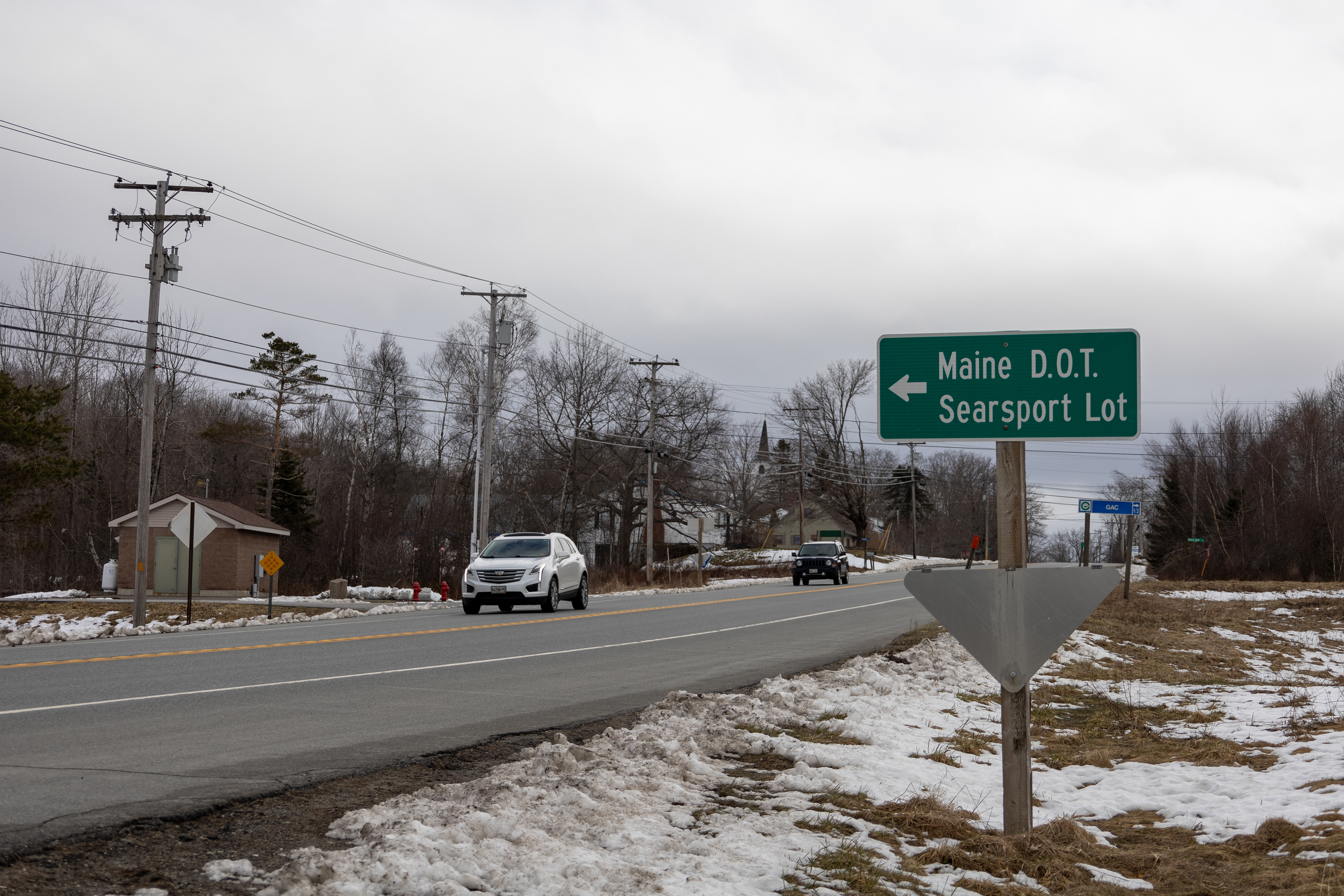
Maine Department of Transportation in Searsport, Maine. The DOT oversees Sears Island.
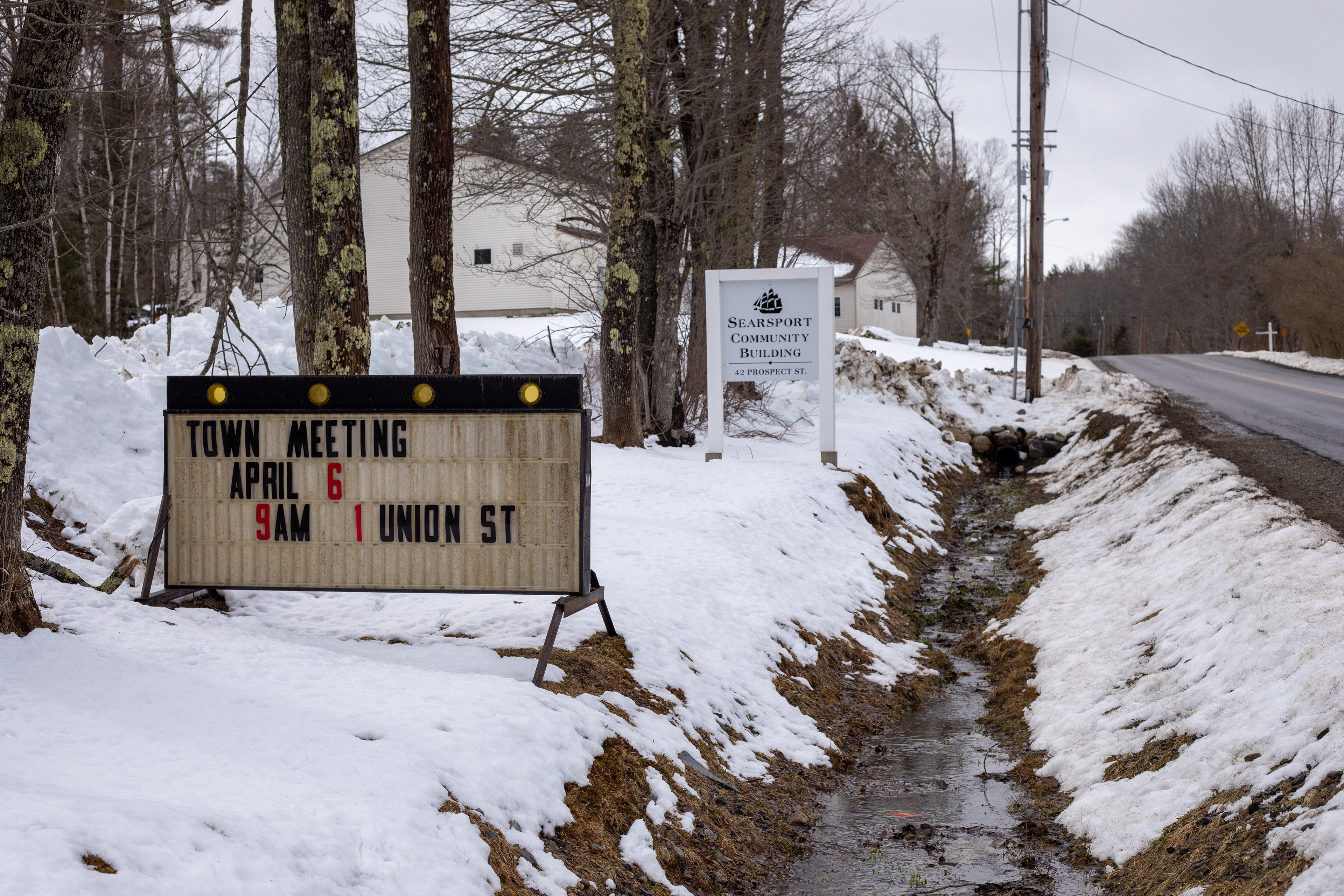
A sign for a town meeting in Searsport in early April.
Rolf Olsen meandered down the paved center road on Sears Island on a breezy morning in early April, holding but never using a collapsible trekking pole. Small patches of dirt-filled snow piled around fallen branches and leaves along the side of the road — a strong winter storm blew through Maine just days before. Olsen, 74, retired in Searsport eight years ago and has since become vice president and spokesperson for Friends of Sears Island.
Average height with a neatly trimmed white beard, clear-framed glasses and a “Friends of Sears Island” baseball cap atop his head, Olsen spoke softly as the cool breeze whipped along the nearby seawater.
“As much as I want to see a real good path for sustainable energy … I worry about this big development on Sears Island for unproven technology,” Olsen said standing on the edge of Sears Island looking out across a cove to Mack Point.
The “unproven technology” he’s talking about is the VolturnUS floating concrete platform designed by the Advanced Structures and Composites Center at the University of Maine to hold massive wind turbines hundreds of miles off the coast in the Gulf of Maine.
If the proposed development port is approved and built on Sears Island, the wind turbines and platforms will be built and launched from the port into the ocean, although the port likely wouldn’t be constructed or operational for several years, and could cost upwards of $500 million, according to the state.
The floating platforms have not been used beyond testing, leaving Olsen and some other community members worried about the proposition of building such a massive project when it’s unclear how well the turbines will perform when they’re eventually launched into the ocean.
The plan is part of the Maine Offshore Wind Initiative, a program overseen by the Department of Energy, working closely with several state, federal and international agencies and governments with the goal of producing 3,000 megawatts of wind power from turbines in the Gulf of Maine by 2040, according to its website.
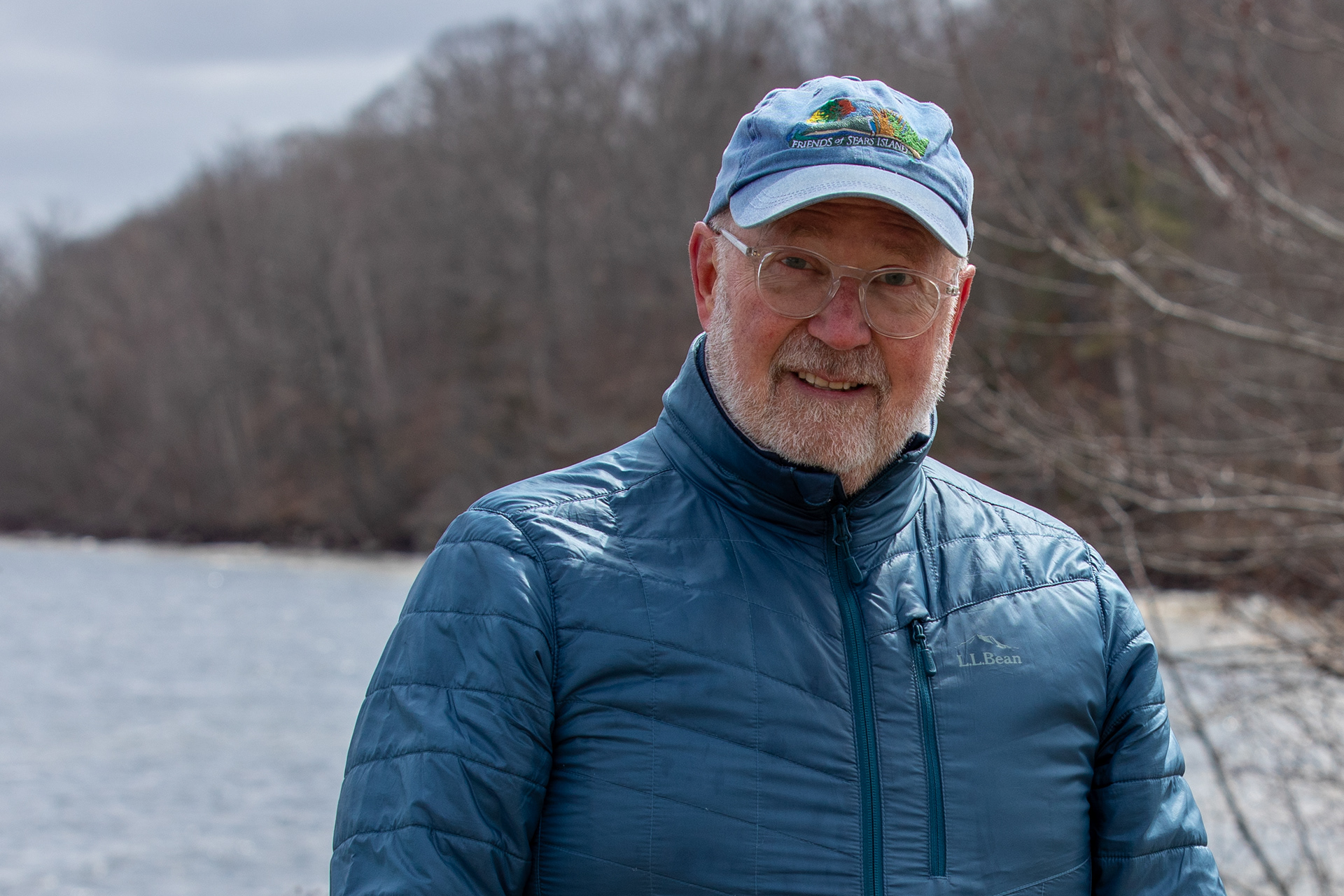
Rolf Olsen poses for a portrait on Sears Island in early April. Olsen is the vice president of Friends of Sears Island and is a leading voice opposing the offshore wind development port being built on the island.

Olsen's car with an "I ♡ Sears Island sticker."
The site selected by the state for the construction is only about 100 acres, but community members like Olsen expressed concern that although the port may ultimately be just 100 acres, construction of such a port would require much more than the existing infrastructure on the island, permanently destroying the ecosystem the island encapsulates.
A new or expanded road may have to be built for large construction trucks to access the island, along with parking lots for construction workers and ultimately the employees of the port, bathroom facilities, fencing, lights, and possibly much more.
In the press release on Feb. 20, Searsport town manager James Gillway said he looks forward to working with the state to “Build a state-of-the-art port facility that is environmentally friendly [while] mitigating the impacts of this development on the local community and environment.”
Several community members expressed their hope for a community benefit agreement, in which the state would provide some form of compensation to the community for the construction of the port, be it increased funding for schools, tax breaks, or replacing traffic lights and expanding the intersection on Main Street to manage the increase of people in the area.
For instance, Salem, Massachusetts, agreed to a $9 billion community benefits agreement with Crowley Wind Services in February, with money set aside for things ranging from funding for impacts to city services, education needs, workforce, and economic development and even funds for fireworks for community celebrations. Crowley is set to develop the Salem Offshore Wind Terminal, a similar plan to the one proposed for Sears Island, in Salem’s deep-water port. Several community members and involved individuals in the proposal point to the Salem CBA as a model for Searsport.
Olsen and other community members made it clear that they’re not opposed to a port to launch offshore wind in Maine, in fact, many say they want one, citing an increase in job opportunities, revenue for the town, diversification and more. They’re just opposed to it being built on Sears Island.
“If you build this in Penobscot Bay, put it on Mack Point, just don’t put it on Sears Island,” said Steve Miller, a member of Alliance for Sears Island and the Isleboro Island Trust.
Mack Point, the alternative location that was under deep consideration by the state, is a currently operational cargo port that sits just a few hundred yards across the cove, owned and operated by Sprague Energy.
The area of Mack Point proposed to be used for the project is a largely desolate and bare pit of gravel, although inaccessible to the public.
The governor and other state officials said there are too many concerns about the potential to build the port there, ranging from the cost since it’s privately owned, environmental concerns of dredging — the excavation of material on the seafloor — and avoiding impacts to existing industry on Mack Point, although Sprague is lobbying for the port to be built there, anyways.
“For more than two years, my Administration has evaluated Sears Island and Mack Point thoroughly and with an open mind,” Mills said in the Feb. 20 press release. “In carefully considering all of these, I believe that, on balance, Sears Island is the best choice for an offshore wind port because it is already owned by the state, designated for the purpose of port development, will cost less in the short-term and long-term, and is expected to result in less environmental harm.”
In yellow, the proposed 100-acre site of the offshore wind port. Credit: Maine DOT
Immediately after the announcement by Mills, several protests were held, including some in neighboring Belfast and the state’s capital, Augusta.
On Sears Island, as Olsen walked along the center road back towards his car, a white Toyota Prius with an “I ♡ Sears Island” sticker on the trunk, he emphasized where he sees his role in the unfolding drama.
“Don’t call me an environmentalist,” he said, also asking not to be called an activist, leaving those titles for people with far more expertise than he says he has. But he has been a vocal advocate for Sears Island’s protection from development for years.
Olsen was a member of Maine’s offshore wind port advisory group, a collection of 19 individuals “representing varied stakeholder viewpoints” that advised the Maine Department of Transportation and Mills on the best location for the port, before she tapped Sears Island as the preferred location in February.
However, the process to approve the proposal and break ground is far from complete, with “extensive and independent State and Federal permitting” still required, including assessments of environmental impacts and alternative sites, like Mack Point, according to Maine’s website.
The Department of Transportation, which oversees Sears Island, says it intends to apply for permits later this year and include opportunities for public and stakeholder input.
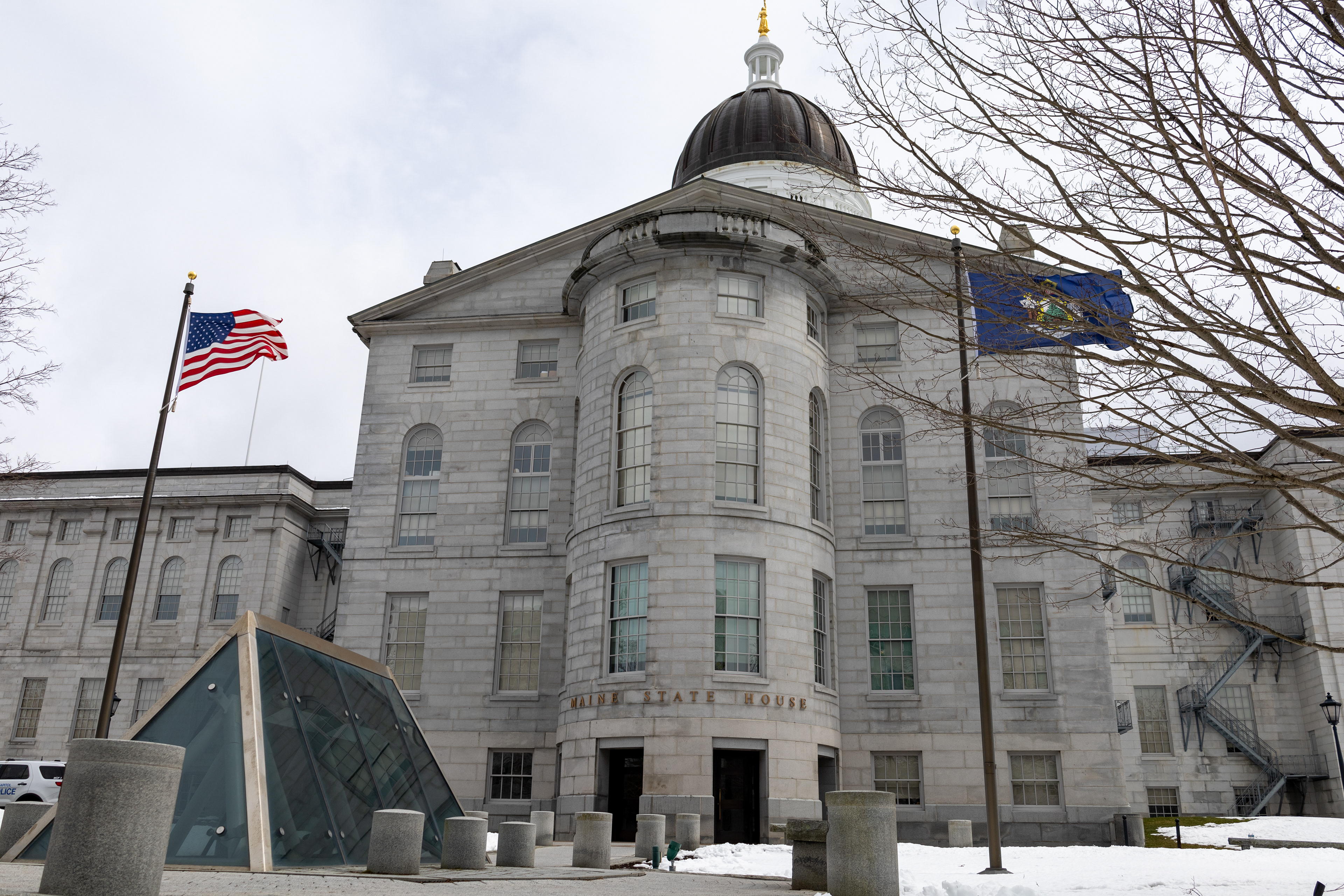
Maine State House in Augusta, Maine.

Maine State House in Augusta, Maine.
In 2007, two years before the state signed an agreement designating two-thirds of the island to be a preservation area and the remaining third a potential future development site, the then commissioner of the Maine Department of Transportation, David Cole, agreed to another agreement.
“Mack Point shall be given preference as an alternative to port development on Sears Island … MaineDOT in conjunction with interested parties, shall investigate and share factual information on the extent to which Mack Point can, in fact, accommodate future marine transportation needs,” the Steering Committee Consensus Agreement said.
Olsen and others point to this agreement as evidence of a broken promise between state officials and community members. They want the port built on Mack Point. But the proposal to build a port today is not the first time the state has attempted to develop land on Sears Island.
Over a century ago, in 1905, the Bangor Investment Company bought the island with plans to build a resort, although it never happened. Nearly 70 years later, in 1971, an oil desulphurization refinery was proposed on the island, and then a few years after that, Central Maine Power proposed a nuclear power plant on the island.
“The Central Maine Power Company feels very good about nuclear-generating plants, is not worried about radiation or accidents, and is proposing to construct a plant on Sears Island in Penobscot Bay,” famed writer E.B. White wrote in The New Yorker on Feb. 24, 1975.
“A group calling itself Safe Power for Maine takes the opposite position and is disturbed that nuclear plants should be built while scientists are still in disagreement and before anyone has found a way to dispose of the nuclear waste safely,” White wrote.
After the plan was nixed by residents, CMPC tried again with a coal-fired plant plan. That too was scuttled. Then, in the 1980s, the state proposed and ultimately built a causeway, as the development proposals for Sears Island also rolled in, followed closely by lawsuits from the conservation group Sierra Club.
A sign on the causeway leading to Sears Island.
A cargo port, liquified natural gas terminal and a freight transport hub for container ships were all proposed at some point but were all ultimately knocked down.
In the late 1980s, the state took 50 acres of the island by eminent domain, and then in 1997 bought the remainder of the island before a series of lawsuits, discussions, committees and agreements were settled that drew the 2009 lines of the conservation area, operated by Friends of Sears Island, and the potential development area, operated by the Maine DOT.
Kyla Bennett, a PhD, lawyer and director of science policy at Public Employees for Environmental Responsibility, known as PEER, wrote a scathing letter to Bruce Van Note, commissioner of Maine DOT in early April, in which she said she expects no response.
In the letter, Bennett, who previously worked at the Environmental Protection Agency in Searsport, expressed her concern with the proposal, citing the many previous proposals, especially the construction of the causeway in the 1980s and subsequent as reasons why.
“PEER understands the need to pivot from fossil fuels,” Bennett wrote. “However, we cannot sacrifice intact ecosystems for this effort.”
In an interview from a house that Bennett said produces its own electricity, she said she was deeply concerned about the proposal on Sears Island and the model it will set for future development projects beyond the confines of coastal Maine.
“My fear is Sears Island is just another example of humans destroying ecosystems in the name of green energy,” Bennett said, criticizing those who push for green energy solutions without looking at the “whole picture.”
In 1995, the EPA released a report evaluating the impact of a proposed dry cargo terminal by the Maine DOT on Sears Island, where it warned of “irreparably harm” to the aquatic environment if built.
Bennett said she is concerned that projects similar to the one proposed on Sears Island may continue to pop up nationwide. If the precedent is set on Sears Island now, Bennett worries the damage to intact ecosystems will have a much bigger downside that can’t simply be offset by an increase in wind energy production.
“Sears Island is not a permittable location for this project,” Bennett said. “It was not a viable alternative in 1996, and it is not today.”
Across the bay in Islseboro, Steve Miller, who, like Olsen, was a member of the advisory group, and also expressed strong opinions about the proposal to build the port on Sears Island.
“The [DOT] has wanted to develop Sears Island since at least 1984 and has failed,” Miller said. “At least one of the reasons their interest in developing Sears Island has failed is that it’s just not suitable for most of the things they’ve wanted to do there.”
Miller, who has two grandchildren, said he feels the nation is at a point where decisions about the climate future may be hard, but must be made carefully.
“We need to make decisions about our climate future that are the best for our climate future because we haven’t been doing that, it is really, really time to do that,” Miller said. “And this is an absolutely super clear example of a governmental entity apparently poised to make a really really awful choice.”

Jannett Williams (L) and Stephene Kelley (R) point to a sign showing how Sears Island has been divided in two between conservation area and future development land.
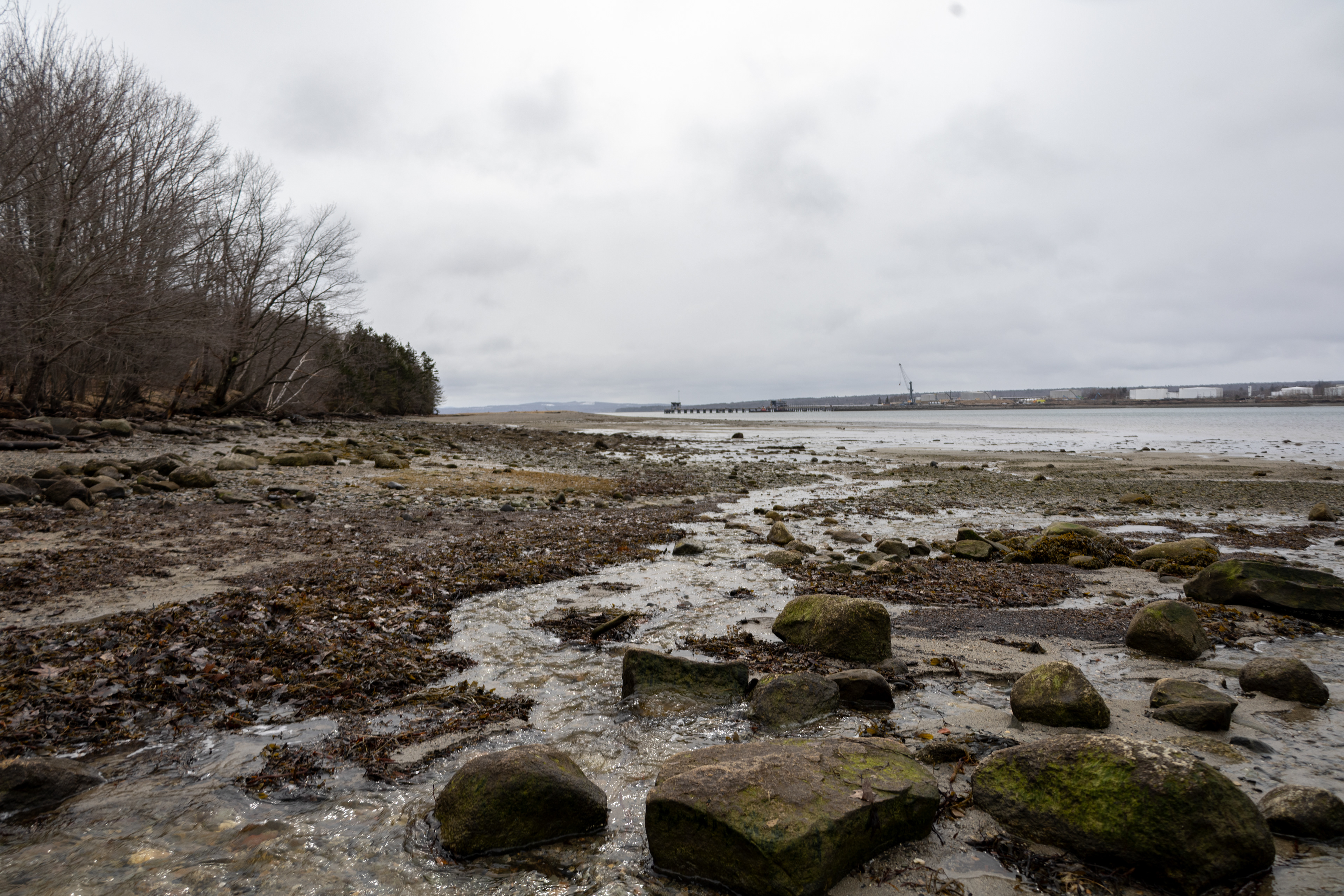
The shore on Sears Island with Mack Point visible across the bay.
As the cold spring air whipped along the center road on Sears Island, Jannett Williams and her friend Stephene Kelley slowly walked up the long road.
“I moved here because of this island,” said Kelley, 74, as her dog Coca wandered off-leash around the trail. She retired in Searsport seven years ago and said she walks the islands’ trails every day.
Kelley, like Olsen, also expressed concern about the “unproven technology” from UMaine.
“Maine is going to take all the impact of all of this,” Kelley said. “Nobody has said what the cost analysis will be, and nobody knows if it’ll even work, so they want to ruin the island because they can’t do the testing [without the port] … and if it doesn’t work they would’ve already destroyed the island.”
Williams, 82, has lived in Searsport since 2007, retiring in the town after living in northeast Ohio for years. She too spends many days on Sears Island, although not every day like Kelley, but still several times a week.
“My heart is so heavy at the thought of this island being destroyed, I just can’t stand it,” she said.
Both Williams and Kelley also expressed their disappointment in the lack of communication from Maine DOT. They said Maine DOT hasn’t held a community forum or town hall for the project, leaving them, along with many others, with several questions. They also shared their concerns about long-term expansion plans on the island beyond the currently proposed port, something Miller also raised.
“It’s the old school developers concept that you want to grow, grow, grow, you want to get big, big, big, you want to have an industrialized port in Penobscot Bay,” Miller said.
Kelley was even more blunt.
“It’s going to ruin [this town],” she said.
When reached, Maine DOT directed all questions about why Sears Island was chosen despite many community members expressing concerns about the project to the press release from Mills on Feb. 20.
Rolf Olsen walking along a trail on Sears Island in early April, just days after winter storm.
If you had to conjure up two people with polarizing political views, you’d be hard-pressed to find people more different than Rolf Olsen and Maine state representative Reagan Paul.
But Paul, a graduate of Liberty University and a Republican state representative in her twenties, elected in 2022 to represent part of Waldo County, and Olsen, found common ground on the topic of Sears Island. Sort of.
Paul campaigned on ending Maine’s renewable portfolio energy standard, exiting the Regional Greenhouse Gas Initiative, resisting future efforts to join the transportation and climate initiative, and incorporating and decommissioning planning and funding to any green energy projects, including the offshore wind initiative.
Her steadfast opposition to an offshore wind port in general meant she was opposed to the idea of a port being proposed on Sears Island as well, and in a January op-ed in The Maine Wire, emphasized the point.
“Currently, there is a more sinister reason why Sears Island is gaining attention in the local press again: it could be the next location on the chopping block as a victim of Maine’s radical climate agenda,” Paul wrote. “That is why I submitted a bill … that, if passed, would have put the entirety of Sears Island into a conservation easement to protect it from any industrialization effort.”
Although Paul’s opposition to the port was for vastly different reasons than many community members in Searsport, an unlikely alliance was still formed opposing the project and seeking protection of the entirety of Sears Island.
There is, of course, a large swath of support for the proposal, some of which comes from the Maine Climate Labor Council and its executive director, Francis Eanes.
“We see offshore wind as one of the most significant ways to tackle the climate crisis,” Eanes said. “And I think it’s both an amazing opportunity … and it is going to be a change. I think it is going to be a transformational project.”
Eanes, whose organization is made up of a collection of labor unions throughout Maine, said he also expects a community benefits agreement and called it a “helpful tool,” adding that there is a tremendous amount of energy and excitement for one.
He also said that MLCC is open to alternative locations the state suggests beyond Sears Island, adding “We will support a port wherever a port is sited, permitted, funded and built.” He said MLCC would “enthusiastically” support a port on Mack Point if it could be successfully done.
But Eanes also said that what’s happening in Maine is not confined to Searsport.
“This is happening everywhere,” Eanes said. “We are talking about interrupting the entire bones of our economy,” one that relies on fossil fuel, emphasizing the importance of now blowing the opportunity.
He pointed out what he views as irony from those opposing the project on Sears Island, raising questions of earlier support for a publicly owned port facility by the same people now opposing the one on Sears Island.
“I find it ironic that some of the same people that were most ardently supportive of the plan to create a publicly owned port facility are now advocating for a private company,” Eanes said, who added that the MLCC has been on the ground knocking on doors in Searsport to discuss the project.
“Although it’s been clear to us that some people have very strong feelings about the siting question,” Eanes said that can “overshadow the opportunity” for what he believes is a positive proposal, one that the MLCC supports moving forward with Sears Island as the location for the time being, despite potential environmental impacts.
“We do have to stipulate that there will have to be impacts on ecosystems,” Eanes said. “And that is still a defensible place to be.”
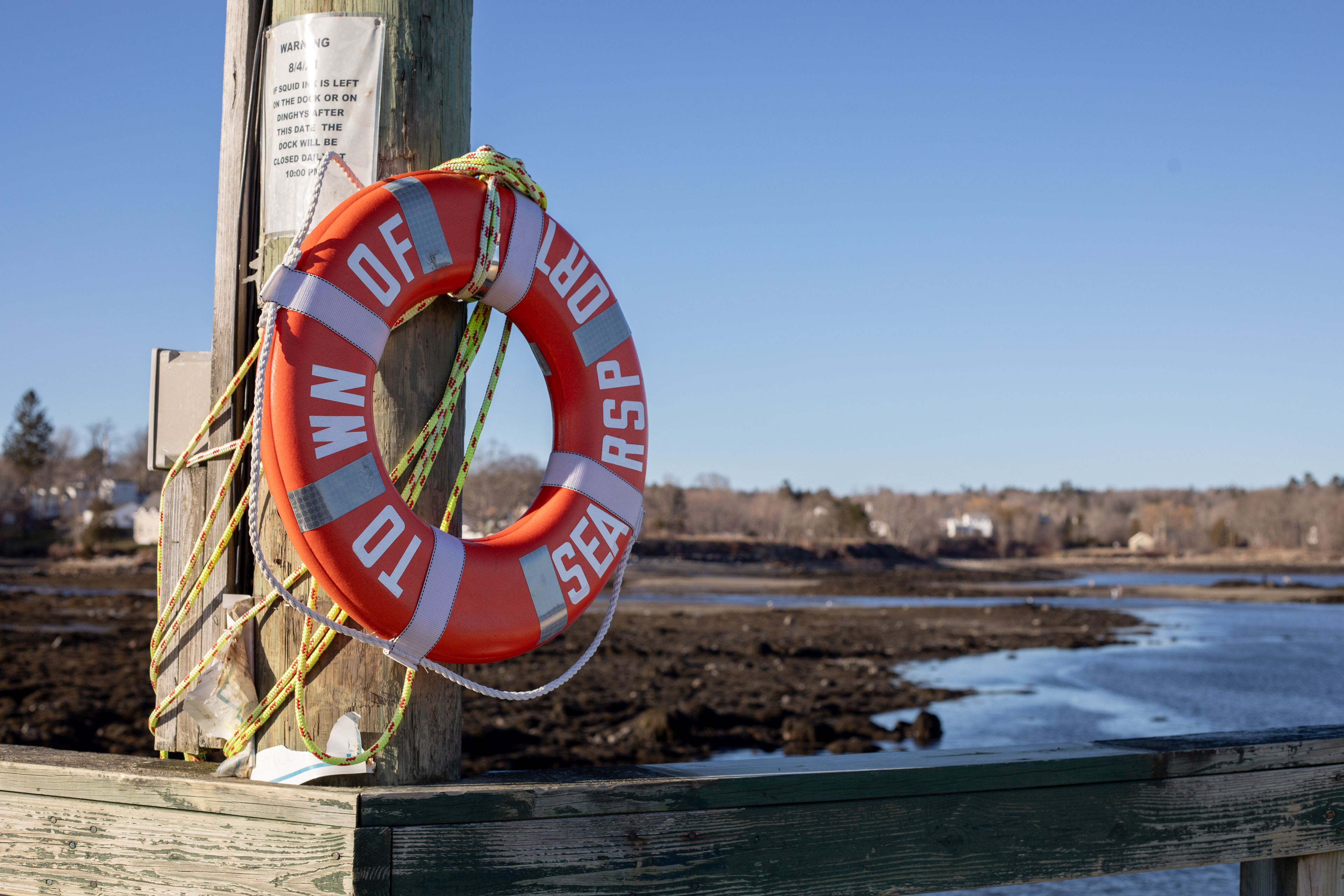
The coastline of the town of Searsport, Maine.
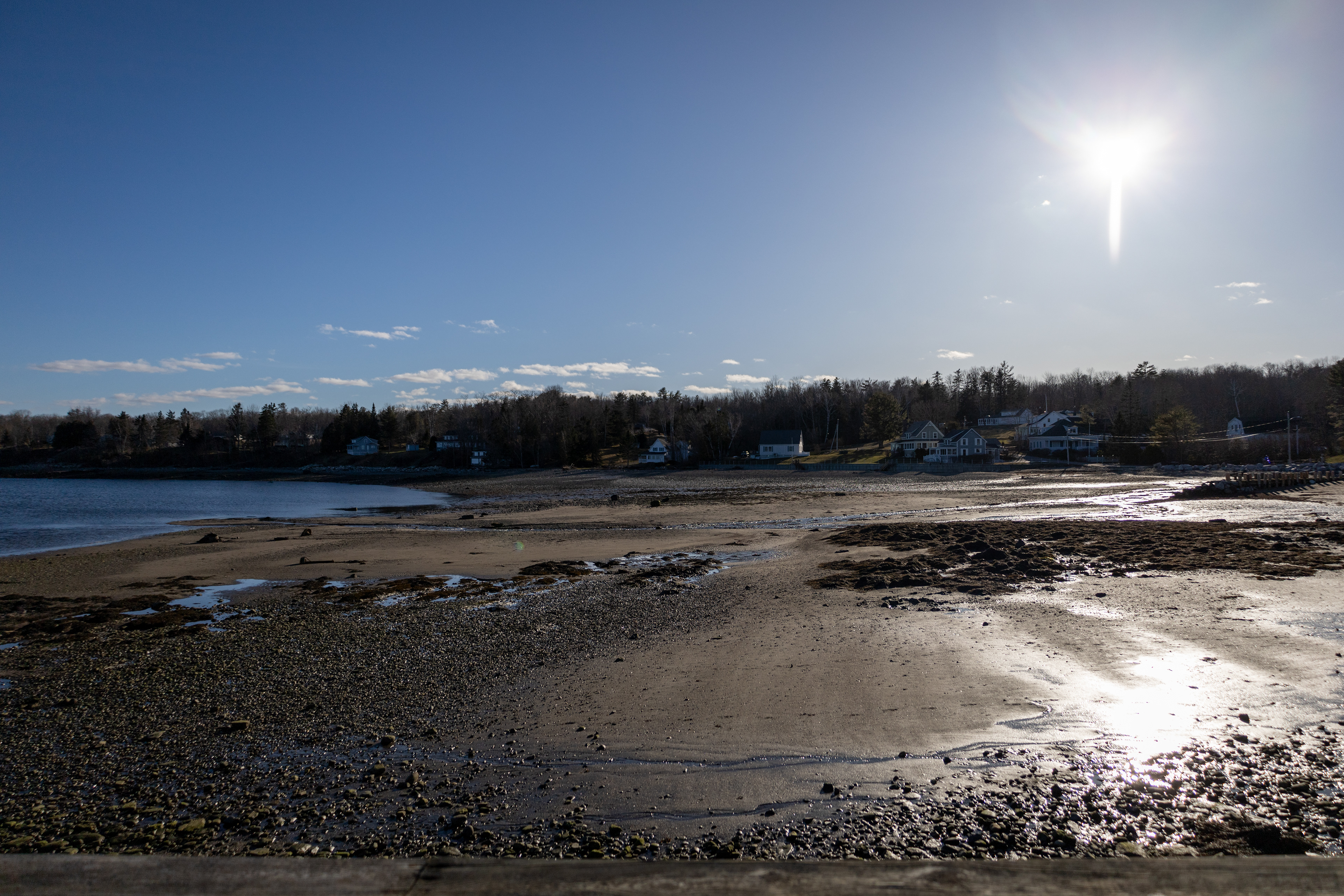
The coastline of the town of Searsport, Maine.
Back in Searsport on a quiet Sunday evening, as the sun began to make its way toward the horizon, slowly casting its long shadows on Main Street, with cars parked sporadically on dirt patches serving as makeshift parking lots, a man with tight pants, boots, a flannel shirt and a fedora stood on the sidewalk, sandwiched between the front door of a restaurant and the construction fence along the road.
The man was Andrew Victor, a Rhode Island-based folk singer, and he was about to begin live music for Hey Sailor!, a trendy and modern Latin-fusion restaurant on Main Street.
Olsen said Hey Sailor! had quickly become popular among locals, one of a few restaurants growing in popularity as the town, like many other small towns, made its way out of COVID-caused business closings.
But step inside and the restaurant sat virtually empty, aside from a group of seven or eight women chatting and laughing and a few people at a high-top table by the window as the early evening sun beamed through.
With its funky theme, half-black walls and ceilings, electric blue, orange and green chairs and a disco ball hanging in the middle, the restaurant seemed out of place in the quiet seaside coastal Maine town.
Victor began stringing away at his guitar at 6 p.m., and by 6:10 p.m. people began to file in, mostly young couples and small groups of three or four, some seemingly for the first time, but many were very clearly regulars.
Another twenty minutes went by and the restaurant was nearly full, as the lights turned blue and the music began to play, as people sipped their beers, ate wings, wood-fired pizza and elaborate tacos.
Amongst the chatter, there didn’t seem to be any mention of Sears Island, offshore wind, multi-million dollar construction projects, or broken promises.
It’ll be months and possibly years until there are answers about Sears Island, Mack Point, permitting the proposal, possible lawsuits and any new legislation is passed. Complex bureaucratic work will run its course and an offshore wind port may eventually be built on Sears Island. Or, like many of the projects proposed before it, may not be.
For now, in Searsport, as seagulls cawed in the distance and Sears Island sat quietly out at sea, a group of people far up Maine’s coast enjoyed their evening in the quiet seaside town.
“The way life should be,” as Maine’s motto puts it, with people young and old chatting, laughing and singing along.
-- --
Note: On Oct. 21, 2024, the U.S. Department of Transportation rejected Maine's request for $456 million to help fund the project. The state would not be able to fund the project without significant federal funding, and it remains unclear what the next steps will be.